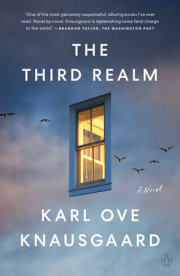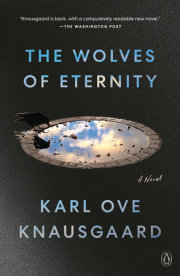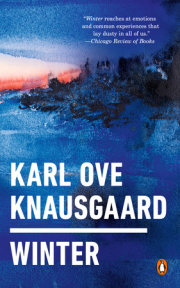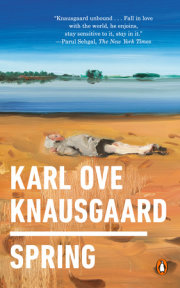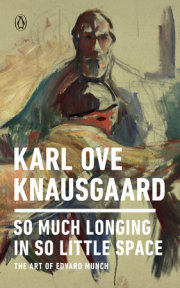28 August. Now, as I write this, you know nothing about anything, about what awaits you, the kind of world you will be born into. And I know nothing about you. I have seen an ultrasound image and have laid my hand on the belly in which you are lying, that is all. Six months remain until you will be born, and anything at all can happen during that time, but I believe that life is strong and indomitable, I think you will be fine, and that you will be born sound and healthy and strong. See the light of day, the expression goes. It was night outside when your eldest sister, Vanja, was born, the darkness filled with swirling snow. Just before she came out, one of the midwives tugged at me, You catch, she said, and so I did, a tiny child slipped out into my hands, slippery as a seal. I was so happy I cried. When Heidi was born one and a half years later, it was autumn and overcast, cold and damp as October can be, she came out during the morning, labour was rapid, and when her head had emerged but not yet the rest of her body, she made a little sound with her lips, it was such a joyous moment. John, as your big brother is called, came out in a cascade of water and blood, the room had no windows, it felt like we were inside a bunker, and when I went out afterwards to call his two grandparents, I was surprised to see the light outside, and that life flowed on as if nothing in particular had happened. It was 15 August 2007, it may have been five or six o'clock in the afternoon, in Malmš, where we had moved the previous summer. Later that evening we drove to a patient hotel, and the day after I went to pick up your sisters, who amused themselves greatly by placing a green rubber lizard on top of John's head. They were three and a half and nearly two years old at the time. I took photos, one day I'll show them to you.
That's how they saw the light of day. Now they are big, now they are used to the world, and the strange thing is that they are so unalike, each of them has a personality entirely their own, and they always did, right from the start. I assume that's how it will be with you too, that you already are the person you will become.
Three siblings, a mother and a father, that's us. That's your family. I mention it first because it's what matters most. Good or bad, warm or cold, strict or indulgent, it doesn't matter, this is the most important thing, these are the relationships through which you will come to view your world, and which will shape your understanding of almost everything, directly or indirectly, both in the form of resistance and of support.
Just now, these past few days, we are fine. While the children were at school today, your mother and I went to Limhamn, and at a cafŽ there, in the late summer heat - today was absolutely marvellous, sun, blue sky, with the faintest hint of autumn in the air, and every colour seemed deep but also bright - we discussed what we are going to call you. I had suggested Anne, if you turn out to be a girl, and now Linda said she really liked the name, there is something light and sunny about it, and that is a quality we want to be associated with you. If you are a boy, your name, we suggested, will be Eirik. Then your name will have the same sound in it as the names of all your three siblings - y - for if you say
them out loud, they all have it - Vanja (Vanya), Heidi (Heydi), John (Yonn).
They are asleep now, all four of them. I am sitting in my study, which is actually a little house with two rooms and a loft, looking out across the lawn towards the house where they are lying, the dark windowpanes which would be invisible if not for the street lamps across the road and the light they cast, which fills the kitchen with a faint ghostly glow. The house is really three cottages in a row, converted into one. Two of them are of red-painted wood, one is of whitewashed brick and plaster. Once upon a time families who worked on one of the big farms in the area lived here. Between these two houses there is a guest house, which we call the summer house. Within the horseshoe shape the buildings form there is the garden, which extends for maybe thirty metres to a white wall. There are two plum trees there, an old one, one of the boughs of which has grown so long and so heavy that it has to be supported on two crutches, and a young one I planted last summer, now bearing fruit for the first time, and a pear tree too, also old, much taller than the houses, and three apple trees. One of the apple trees was in pretty bad shape, many of the branches were dead, it seemed stiff and lifeless, but then I pruned it earlier this summer, which I've never done before, and I grew so eager I kept cutting and cutting without stopping to look how it was turning out, until finally, late in the evening, I climbed down and took a few steps back to look at it. Maimed was the word that came to mind. But the branches have grown back, densely covered with leaves, and the tree is loaded with apples. That's the experience I've gained from working in the garden: there's no reason to be cautious or anxious about anything, life is so robust, it seems to come cascading, blind and green, and at times it is frightening, because we too are alive, but we live in what amounts to a controlled environment, which makes us fear whatever is blind, wild, chaotic, stretching towards the sun, but most often also beautiful, in a deeper way than the purely visual, for the soil smells of rot and darkness, teems with scuttling beetles and convulsing worms, the flower stalks are juicy, their petals brim with scents, and the air, cold and sharp, warm and humid, filled with sunrays or rain, lies against skin, accustomed to the indoors, like a soothing compress of hereness. Behind the main house lies the road, which ends some hundred metres further on, in a sort of abandoned little semi-industrial area, the buildings have corrugated tin roofs and the windows are broken, engines and axle shafts lie rusting outside, almost disappearing into the grass. On the other side, behind the house in which I am sitting, there is a large farm building made of red brick, it is beautiful to look at, towering up amid the green foliage.
Red and green.
They mean nothing to you, but to me those two colours contain so much, something within them exerts a powerful pull, and I think this is one of the reasons why I have become a writer, for I feel that pull so strongly, and I know that it's important, but I lack the words to express it, and therefore I don't know what it is. I have tried, and I have capitulated. My capitulation is the books I have published. You can read them some day, and maybe you will understand what I mean.
The blood flowing through the veins, the grass growing in the soil, the trees, oh the trees swaying in the wind.
These astounding things, which you will soon encounter and see for yourself, are so easy to lose sight of, and there are almost as many ways of doing that as there are people. That is why I am writing this book for you. I want to show you the world, as it is, all around us, all the time. Only by doing so will I myself be able to glimpse it.
What makes life worth living?
No child asks itself that question. To children life is self-evident. Life goes without saying: whether it is good or bad makes no difference. This is because children don't see the world, don't observe the world, don't contemplate the world, but are so deeply immersed in the world that they don't distinguish between it and their own selves. Not until that happens, until a distance appears between what they are and what the world is, does the question arise: what makes life worth living?
Is it the feeling of pressing down the door handle and pushing the door open, feeling it swing inward or outward on its hinges, always easily and willingly, and entering a new room?
Yes, the door opens, like a wing, and that alone makes life worth living.
To someone who has lived for many years, the door is obvious. The house is obvious, the garden is obvious, the sky and the sea are obvious, even the moon, suspended in the night sky and shining brightly above the rooftops, is obvious. The world expresses its being, but we are not listening, and since we are no longer immersed in it, experiencing it as a part of ourselves, it is as if it escapes us. We open the door, but it doesn't mean anything, it's nothing, just something we do to get from one room to another.
I want to show you our world as it is now: the door, the floor, the water tap and the sink, the garden chair close to the wall beneath the kitchen window, the sun, the water, the trees. You will come to see it in your own way, you will experience things for yourself and live a life of your own, so of course it is primarily for my own sake that I am doing this: showing you the world, little one, makes my life worth living.
SEPTEMBER
Apples
For some reason or other, the fruits that grow in the Nordic countries are easily accessible, with only a thin skin that yields readily covering their flesh, this is true for pears and apples as well as for plums, all one needs to do is bite into them and gobble them down, while the fruits that grow further south, like oranges, mandarins, bananas, pomegranates, mangoes and passion fruit, are often covered with thick, inedible skins. Normally, in accordance with my other preferences in life, I prefer the latter, both because the notion that pleasure must be deserved through prior effort is so strong in me, and because I have always been drawn towards the hidden and the secret. To bite a piece of the peel from the top of an orange in order to work one's thumb in between the peel and the flesh of the orange, and feel the bitter taste spurting into one's mouth for a brief second, and then to loosen piece after piece, sometimes, if the peel is thin, in tiny scraps, other times, when the peel is thick and loosely connected to the flesh, in one long piece, also has a ritual aspect to it. It is almost as if first one is in the temple colonnade and moving slowly towards the innermost room, but there the teeth pierce the thin, shiny membrane and the fruit juice runs into the mouth and fills it with sweetness. Both the labour involved and the fruit's secretive nature, by which I mean its inaccessibility, increase the value of the pleasure one experiences. The apple is an exception to this. All one has to do is reach up a hand, grab the apple and sink one's teeth into it. No work, no secret, just straight into pleasure, the almost explosive release of the apple's sharp, fresh and tart yet always sweet taste into the mouth, which may cause the nerves to twinge and maybe also the facial muscles to contract, as if the distance between man and fruit is just big enough for this shock on a miniature scale to never quite disappear, regardless of how many apples one has eaten in one's life.
When I was a fairly small child, I began to eat the whole apple. Not just the flesh, but the core with all the pips in it, even the stem. Not because it tasted good, I don't think, nor because of any idea I might have had that I shouldn't be wasteful, but because eating the core and the stem presented an obstacle to pleasure. It was work of a kind, even if in reverse order: first the reward, then the effort. It is still unthinkable for me to throw away an apple core, and when I see my children doing it - sometimes they even throw away half-eaten apples - I am filled with indignation, but I don't say anything, because I want them to relish life and to have a sense of its abundance. I want them to feel that living is easy. And this is why I've changed my attitude towards apples, not through an act of will, but as a result of having seen and understood more, I think, and now I know that it is never really about the world in itself, merely about our way of relating to it. Against secrecy stands openness, against work stands freedom. Last Sunday we went to the beach about ten kilometres from here, it was one of those early autumn days which summer had stretched into and saturated almost completely with its warmth and calm, yet the tourists had gone home long ago and the beach lay deserted. I took the children for a walk in the forest, which grows all the way down to the edge of the sand, and which for the most part consists of deciduous trees, with the occasional red-trunked pine. The air was warm and still, the sun hung heavy with light on the faintly dark blue sky. We followed a path in between the trees, and there, in the middle of the wood, stood an apple tree laden with apples. The children were as astonished as I was, apple trees are supposed to grow in gardens, not wild out in the forest. Can we eat them, they asked. I said yes, go ahead, take as many as you want. In a sudden glimpse, as full of joy as it was of sorrow, I understood what freedom is.
Wasps
The body of a wasp is divided into two parts, of which the hindmost is shaped something like a faintly rounded cone, with a smooth and shiny surface, while the front part is more spherical and only a third of the length of the hind part, and yet the legs, the wings and the antennae all extend from the front. With its yellow and black pattern, shiny surface and rounded conical shape, the hind part resembles a tiny Easter egg, or maybe a miniature FabergŽ egg, for if one looks closely, it is striking how regular and beautiful the pattern is; the black stripes divide up the field of yellow like slender ribbons, and where the black dots lie adjacent to the stripes, they resemble painstakingly painted decorative borders. Its hardness - which to us seems not very great, it takes no more than a slight pressure of the fingers for the shell to crack and the soft innards to ooze out, but which must seem like armour plating in the world of the wasp - brings to mind a suit of armour, and when the wasp comes flying, with its six legs, two pairs of wings and two antennae, it is almost like a knight dressed for battle. This is what I thought last week, when the weather was splendid and summery and I decided to seize the opportunity and paint the west wall of the house. I knew there had to be a wasps' nest inside the air vent, for we could often hear buzzing behind the wall when we went to bed in the evening, and it stopped just where the wasps crawled in, and sometimes a few of them even got into the room, though both the window and the door were shut. As I put the ladder up and, with paint can and brush in one hand, climbed far enough to reach the boards below the eaves, I didn't give them a thought, for even though they dwelled only a few feet from our bed, they had never turned against us, it was as if we didn't exist to them or were only a part of the backdrop they lived their lives against. But this afternoon that changed. As soon as I started painting, I heard a faint scratching sound from the air vent and a wasp came crawling out, took off from the edge and with a buzz flew up maybe twenty metres into the air, where it was no more than a tiny speck against the vast blue of the sky, before it came diving straight at me at the same time as another wasp came crawling out of the air vent, and another and another. All in all five wasps circled around me. I tried shooing them away with my left hand, carefully so as not to fall, but of course that didn't help at all. They didn't sting me, but their aggressive movements and their angry buzzing were enough to make me climb down and light a cigarette as I pondered what to do. There was something humiliating about my situation, compared to me they were so tiny, no bigger than my outermost finger joints, and considerably thinner. I fetched the fly swatter from the kitchen and climbed back up. No sooner had I dipped the brush into the oily red paint and applied the first strokes than I heard the scratching noise again. Soon the first wasp was out on the edge of the vent and
letting itself drop down into the air before circling me; shortly afterwards I was surrounded again. I struck out at them and hit a couple, but only in mid-air, and all that happened was they were knocked off course. I hardly got any painting done. I gave up, poured the paint back into the larger can and cleaned the brush. A few hours later I climbed the ladder as gently as I could, sealed the air vent with gaffer tape, tiptoed down again, hurried inside up to the bedroom, where I taped shut the inside of the vent as well. When we went to bed that evening, the buzzing outside didn't cease. Nor the evening after. But then it went quiet.
Copyright © 2019 by Karl Ove Knausgaard. All rights reserved. No part of this excerpt may be reproduced or reprinted without permission in writing from the publisher.







